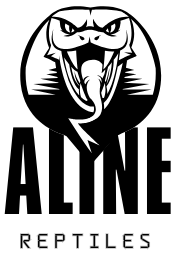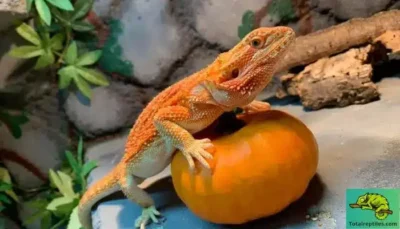It’s fall. Pumpkins are everywhere—from soups to pies, decorations to treats. As you carve out your jack-o’-lantern or prepare a pumpkin-based dish, you glance over at your scaly little companion and wonder: Can bearded dragons eat pumpkin?
If you’re a caring and curious beardie owner, you’ve probably found yourself Googling whether this vibrant orange vegetable is safe for your reptilian friend. Bearded dragons have specific dietary needs, and feeding them the wrong foods—even healthy human options—can cause health issues.
In this post we’ll walk you through everything you need to know about feeding pumpkin to bearded dragons, from nutritional facts and preparation tips to common risks and frequently asked questions.
Is Pumpkin Safe for Bearded Dragons?
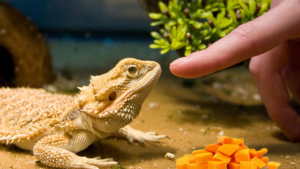
The good news is that pumpkin is not toxic to bearded dragons. It’s one of the many vegetables that they can eat. However, not everything that’s safe is necessarily healthy in large amounts, and pumpkin falls squarely into that category.
While pumpkin does offer some beneficial nutrients like Vitamin A and fiber, it also comes with nutritional drawbacks, especially when overfed. The key here is moderation and proper preparation.
Nutritional Profile of Pumpkin
Before feeding anything to your beardie, it’s important to understand its nutritional composition. Here’s a quick look at what 100g of raw pumpkin provides:
| Nutrient | Amount | Benefits/Concerns |
|---|---|---|
| Calories | 26 kcal | Low-calorie; good for light feeding |
| Water | 91.6g | High water content; may cause loose stool |
| Vitamin A | 426 µg | Supports vision & skin; excess may lead to toxicity |
| Fiber | 0.5g | Helps digestion in small amounts |
| Calcium | 21 mg | Essential for bone health |
| Phosphorus | 44 mg | Interferes with calcium absorption |
| Calcium:Phosphorus Ratio | 1:2.1 | Unbalanced; may lead to metabolic bone disease (MBD) |
🔎 Key Takeaway: Pumpkin has a poor calcium-to-phosphorus ratio (ideal is 2:1 in favor of calcium). This imbalance makes pumpkin an occasional snack—not a regular diet item.
Risks of Feeding Too Much Pumpkin
Although it may seem harmless, regularly feeding pumpkin can pose several risks to your bearded dragon’s health:
1. Poor Calcium Absorption
Pumpkin contains more phosphorus than calcium, which can bind with calcium in the body and prevent its absorption. Over time, this may lead to Metabolic Bone Disease (MBD)—a serious and painful condition that causes brittle bones, deformities, and lethargy.
2. Loose Stool and Dehydration
Pumpkin is high in water. While some moisture is good, too much can cause runny droppings, leading to dehydration and digestive discomfort.
3. Vitamin A Toxicity
Pumpkin is rich in beta-carotene, which converts to Vitamin A. If your beardie is already on a supplement or consumes many Vitamin A-rich foods, the risk of toxicity increases.
How to Safely Feed Pumpkin to Your Bearded Dragon
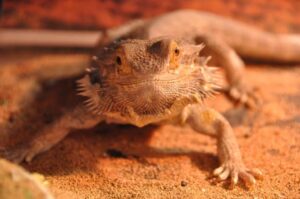
If you’re still interested in offering a bit of pumpkin to your beardie, great! Just make sure you do it the right way.
What Type of Pumpkin Is Best?
| Type | Safe? | Notes |
|---|---|---|
| Raw Pumpkin | Yes | Best when finely grated or chopped |
| Cooked Pumpkin | Yes | Lightly steamed; never with seasoning |
| Canned Pumpkin | ❌ No | Often contains sugars and preservatives |
| Pumpkin Seeds | ❌ No | Choking hazard and indigestible |
| Pumpkin Leaves | ⚠️ Rarely | May be high in oxalates; offer with caution |
Preparation Instructions:
-
Choose a fresh, organic pumpkin.
-
Peel and remove the seeds completely.
-
Grate, chop, or lightly steam small pieces.
-
Serve raw or lightly steamed—avoid adding spices, salt, or oil.
-
Feed as a treat, mixed with other leafy greens.
How Often Can They Eat It?
-
Adult bearded dragons: Once every 2–3 weeks
-
Juveniles: Best to avoid or feed once a month
-
Portion: 1–2 teaspoons at a time
Best Alternatives to Pumpkin for Bearded Dragons
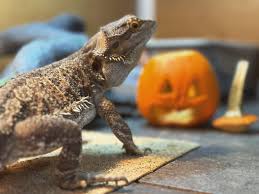
While pumpkin can be an occasional addition, there are far healthier vegetables you should be prioritizing in your beardie’s diet:
| Vegetable | Calcium:Phosphorus Ratio | Benefits |
|---|---|---|
| Collard Greens | 14.5:1 | Excellent calcium source |
| Mustard Greens | 2.4:1 | High in fiber and vitamins |
| Dandelion Greens | 2.8:1 | Great daily green; supports digestion |
| Butternut Squash | 1.4:1 | Slightly better than pumpkin |
| Turnip Greens | 4.5:1 | High calcium and Vitamin A |
✅ Mix these regularly into their salad base. Add pumpkin as a rotational treat rather than a staple.
Frequently Asked Questions (FAQs)
1. Can Baby Bearded Dragons Eat Pumpkin?
It’s best to avoid feeding pumpkin to babies. They need more calcium-rich, high-protein foods to support growth. Stick to dark leafy greens and gut-loaded insects.
2. Can They Eat Pumpkin Seeds?
No. Pumpkin seeds are a choking hazard and difficult for bearded dragons to digest.
3. Can Bearded Dragons Eat Canned Pumpkin or Puree?
❌ Avoid canned pumpkin or any processed version. These often contain preservatives, sugar, and salt, which are harmful to reptiles.
4. Is Pumpkin Good During Brumation?
No. During brumation (a reptile’s form of hibernation), they eat very little, if at all. Feeding pumpkin during this time may upset their digestive system.
Quick Summary Table
| Question | Answer |
|---|---|
| Can beardies eat raw pumpkin? | Yes, in moderation |
| Can they eat cooked pumpkin? | Yes, if unseasoned and plain |
| Is pumpkin nutritious? | Somewhat; low calcium makes it risky |
| How often can they have pumpkin? | Once every 2–3 weeks |
| Is it safe for baby beardies? | Not recommended |
| Can they eat pumpkin seeds? | No |
| What are better alternatives? | Collard greens, dandelion greens, squash |
Conclusion
To wrap it up the question Can bearded dragons eat pumpkin? Pumpkin can be a fun, seasonal treat for your bearded dragon, but it shouldn’t become a regular part of their diet. While it provides some hydration and nutrients, its low calcium and high phosphorus content make it unsuitable for frequent feeding.
Stick to a diet rich in calcium-dense greens, live insects (for younger dragons), and occasional fruits or veggies like pumpkin. With proper care and attention to what they eat, your bearded dragon will thrive—and may even enjoy that tiny pumpkin snack from time to time!
